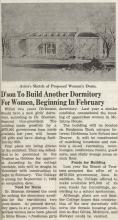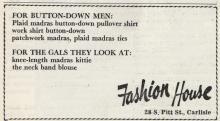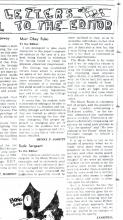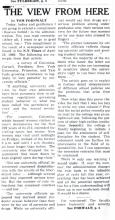For the gals they look at
An advertisement in The Dickinsonian for the Fashion House, a store on Pitt Street in Carlisle, offered clothing for men and women. It advertises men's clothing with "For the button-down men: Plaid madras button-down pullover shirt...." For women's clothing, on the other hand, it reads, "For the gals they look at: knee-length madras kitties...."
Women's Regulations under Scrutiny
According to an article in The Dickinsonian, the Social Rules Evaluation Committee, formed to address the potential change to social rules, chose to evaluate women's regulations and sorority social regulations. The committee adopted this philosophy for procedure: "The work of this committee is predicted [sic] on the belief that college students are mature, responsible people capable of setting up a sound, acceptable social code of their own and also of enforcing this code upon themselves...."
Puritannical Rules and No Place to Go
The Dickinsonian reports on the issue of campus rules and surveys student opinions. One fraternity man described the social rules as puritannical. Bill Jones disagreed with the rule regarding women visitors in fraternity houses. According to the article, many students expressed disatisfaction over the "lack of places for couples or mixed groups to meet informally...." Shirley Bahrs complained of the lack of activities on campus, and Betsy Kraft bemoaned the fact that Drayer Hall, a women's dormitory, had no recreation room.
What's Legal Doesn't Meet Our Needs, What's Fun Is Tagged Taboo
A poem by Carla Russ (Class of 1964) in The Dickinsonian addressed the lack of activities for female students. Entitled A Pertinent Poem, it begins "Mary, Mary quite contrary, what did you do tonight?" The poem uses four names as inspiration for rhyme schemes (Mary, Jeanie, Pammy, Joanie), posing a question to each character. Their responses are all variations on the same theme, and the last section, which addresses Joanie, complains, "What's legal doesn't meet our needs,/ What's fun is tagged taboo!"
Does extended curfew mean more pregnancies?
An editorial in The Dickinsonian criticizes campus social rules, especially those that pertain to women. The author insists that students are capable of behaving well and gives the example of the faculty allowing women visitors upstairs in fraternities, which "did not result in an upsurge of pregnancies." The editorial calls upon the Women's Interdormitory Council to extend these curfews on weekends to bring Dickinson's policies in line with comparable schools. The author also believes that the college should allow drinking upstairs in the fraternity when women are not present.
Modern-Day Cinderella
A cartoon in The Dickinsonian humorously depicts curfew rules for co-ed students. With "Modern-Day Cinderella" at the bottom, the cartoon shows a befuddled-looking prince who watches as a young woman steps into a pumpkin carriage with only one shoe. The clock tower in the background appears to strike eleven o' clock with the words "Bong, Bong" next to it.
No Love-Making in the Union
A Letter to the Editor in the February 25, 1966 issue of the Dickinsonian critiqued the behavior of the Music Room sergeant. According to "Janettja," the sergeant was trespassing on the privacy of students who frequented the music room by addressing them with phrases like "Cut the passion" and "No love-making in the Union" in response to a "friendly kiss."
Vogue as the new Men's Magazine at Dickinson?
In "The Unparalleled Men's Magazine: 'Vogue,'" David Bedick refers to an article in the previous issue of The Dickinsonian and uses it as a springboard for a satirical piece on Vogue as a men's magazine. Bedick jokes that Vogue "does away with mere pretentions to literary-philosophical offerings and concentrates, instead, on presenting page after page of the most beautiful women in the world."
The View from Here: Dorm Rules and the Sexual Revolution
In "The View from Here," Tom Fornwalt responds to a New York Times article of April 25, 1966 that addresses the university's role in student life. According to this article, some universities surveyed were reluctant to legislate student conduct "in loco parentis," although they have been slow to adjust to the sexual revolution. University officials expressed more concern with drug use than with students' sexual behavior.










